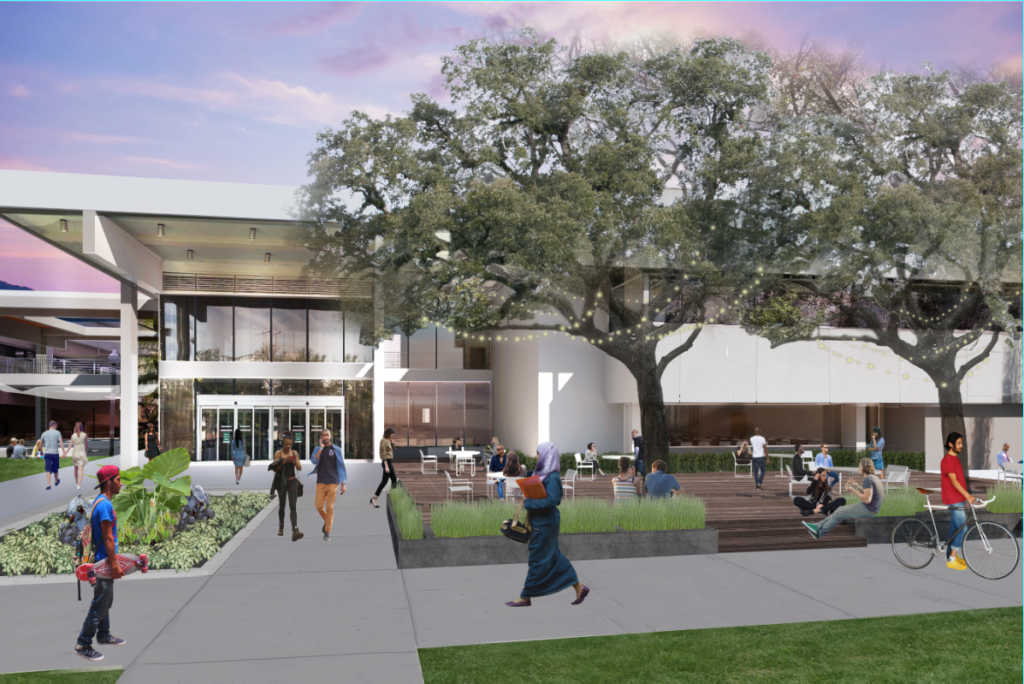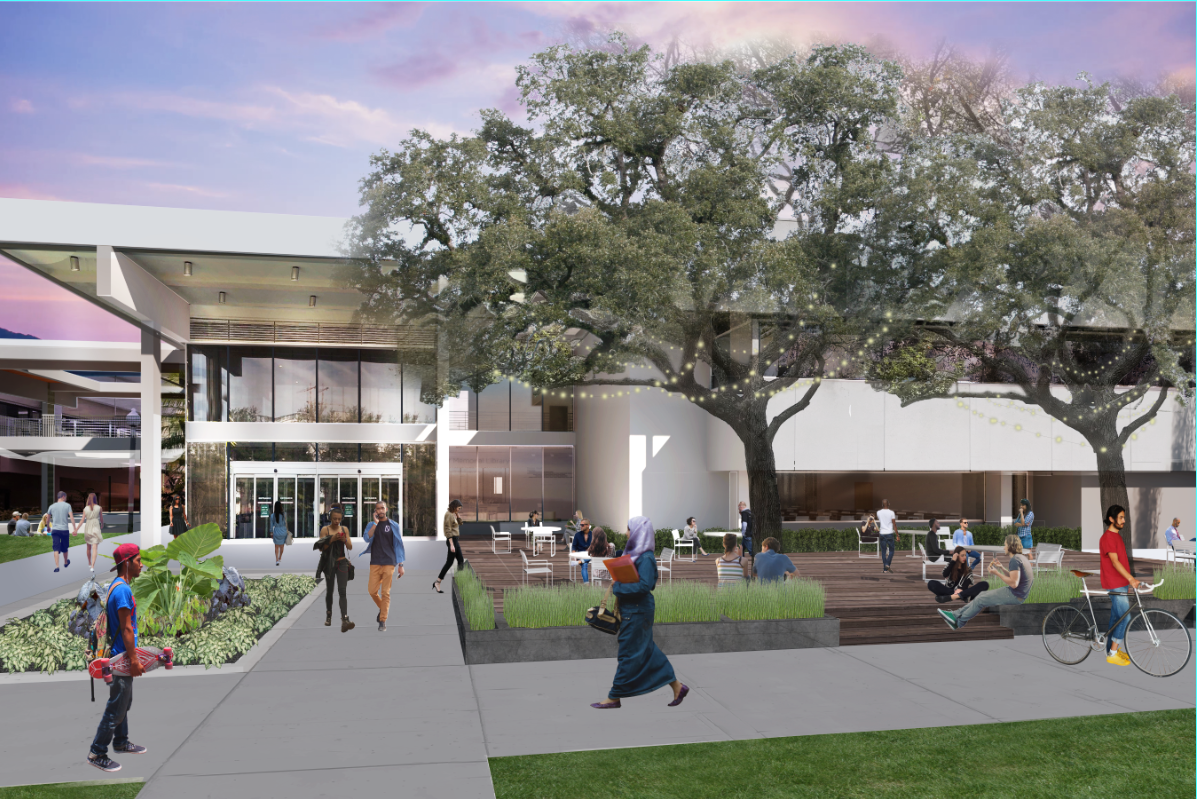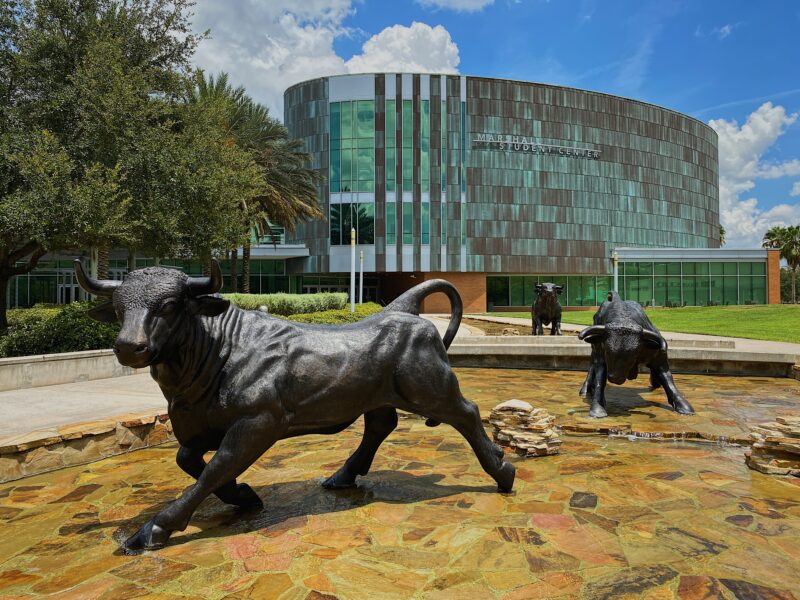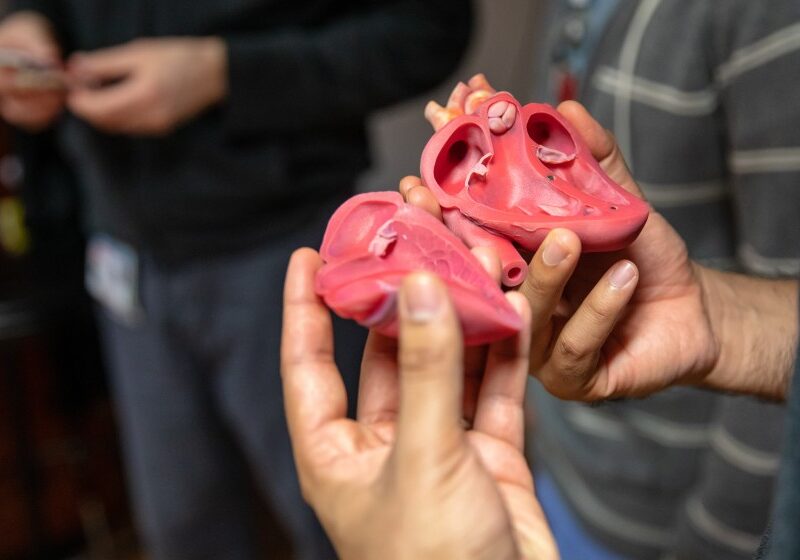
By Michael Moore Jr.
When students returned to campus following winter break, they found mounds of dirt, walls of silk fencing and yellow caution tape outside Nelson Poynter Memorial Library.
The $400,000 project to renovate the area outside the library and in between Bayboro Hall aims to transform the space into a “destination area” and hangout spot for students, according to Edward Lewis, USF St. Petersburg’s construction project manager.
“We wanted to do something that would have an impact on the students,” said Kaya van Beynen, interim associate dean at the library. “This was funded by the students, so we wanted to do something that wasn’t just fixing things that no one would see. We looked at a lot of options and we came up with the two sections that we’re currently focusing on.”
The first section is the space in front of the library, which is being developed into a decked seating area furnished with tables and chairs beneath the canopy of trees and the LED fairy lights, which the library hopes will eventually be strung from them, though lighting doesn’t fall within the budget as it stands.
The second section is the slot tucked between the library and Bayboro Hall, which will become a common area where students can lounge beneath a fabric shade sail and take advantage of the bayfront view without baking in the Florida sun.
Construction began in early January and is scheduled to be completed before final exam week in late March or early April, if all goes according to plan. There will also be increased wireless connectivity in the areas.
The money for the renovation was allocated by the university’s Capital Improvement Trust Fund – a fund for major student infrastructure projects that is paid for by student fees.
The Capital Improvement Trust Fund is set at a state-wide rate of at least $4.76 per credit hour per semester and cannot exceed 10 percent of tuition for resident students. Beginning in 2012, university boards of trustees were authorized by the state legislature to increase the fee.
USF St. Petersburg’s rate sits at $6.76 per credit hour per semester, according to the Florida Board of Governors website, which puts it on par with other universities within the state.
The fund is appropriated by a committee that consists of six faculty members and six students appointed by the student body president, according to Dwayne Isaacs, who has chaired USF St. Petersburg’s committee for the past two years.
The money can’t be used for academic buildings, but instead must be utilized in support of student services, according to Isaacs. This means that the interior of the library, which is set to be renovated sometime in the future, would not qualify under these funds – but the outside common areas do.
The fund has been used in the past on the Student Life Center, and more recently The Edge.
Lewis, who is responsible for facilitating and coordinating on-campus projects such as these, said the renovations will improve campus aesthetics while giving students another spot.
“In its conception, we wanted to do something to tidy it up,” Lewis said. “But also we wanted to get some more outside space that was practical and could be used for students to sort of hang out and relax, whether you’re an introvert and want to go and read somewhere or whether you’re an extrovert and want to go outside and get together with your friends.”
Van Beynen sees the increased tidiness as a way of making that side of campus more visibly pleasing.
“I don’t know how many people noticed, but that area had become a parking lot. All the golf carts were sitting there all the time. And, you know, it’s got a lovely view of the water,” she said.
While some students said they don’t see the improvements as necessary, many agreed that the new areas could be an interesting new spot for students.
Britney Clarke, an 18-year-old freshman biology student, said that while she didn’t know if our campus was big enough to warrant more hangout areas, it would “probably be a good new place for students to de-stress.”
Angelique Gilbert, 17, who is a freshman education major, agreed.
“I didn’t really think it was a problem the way it was before, but I bet students will enjoy it,” Gilbert said.
Her biggest concern was over the ongoing construction and the potential for it to get in the way.
“I was thinking they should have done this over one of the breaks,” she said. She was, however, quick to add that the workers had done an excellent job thus far at staying out of the way and not impeding any of the sidewalks. Her routes to class have been clear so far, she said.
Both van Beynen and Lewis said that construction on the project, which has been in the planning stages from conception for close to a year now, was primarily being done in the morning, with great care being taken not to disturb any students. Construction could not have been completed during the duration of any of the breaks, they said.
Gilbert said she would definitely use the new location once completed and doesn’t think she will be alone in that regard.
“I think students will love it,” she said.
The project was designed by BFrank Studio’s Beverly Frank, the same architect behind The Edge. It was initially designed to include a fountain, but that drove the estimated quote up to over $1 million, well beyond the budget allotted by CITF.
The outside construction comes at a time when the library is fundraising to renovate its first floor.
Josephine Hall, a longtime patron of the arts and USF St. Petersburg community member, left behind a generous $2 million donation to the university that was announced by Regional Chancellor Martin Tadlock in October.
Half of that went toward the potential renovation of the library’s first floor – but initial quotes set the renovation as costing somewhere between $4 and $7 million, according to van Beynen.
Plans for the library include changes in entry points that will allow for increased security protocol in the hopes of allowing 24/7 access to the library, something that has been requested by students for years.
The renovations would also include bigger tables, more comfortable furnishings and far more utilization of natural sunlight, while doubling the number of study rooms, which van Beynen said was one of the most requested items by students while collecting input for the plans.
It would also feature a brand new event space.
While these changes are likely years away as the library continues to seek additional funds, they have already begun preparing by downsizing space utilized for things that are also digitally housed, such as print magazines, newspapers and VHS tapes.
“We’re kind of one-stop-shopping and I think we just try to be as accommodating as possible and make students comfortable,” van Beynen said. “I think students like coming to the library because we provide a welcoming space and we do our best to help students however we can.”



